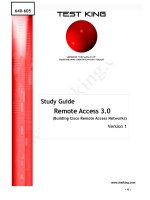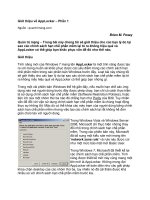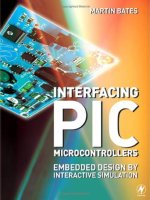Interfacing PIC Microcontrollers 1 ppt
Bạn đang xem bản rút gọn của tài liệu. Xem và tải ngay bản đầy đủ của tài liệu tại đây (261.3 KB, 10 trang )
Interfacing PIC Microcontrollers
Embedded Design by Interactive Simulation
Else_IPM-BATES_fm.qxd 7/20/2006 11:52 AM Page i
i
This page intentionally left blank
ii
Interfacing PIC Microcontrollers
Embedded Design by Interactive Simulation
Martin Bates
Amsterdam
●
Boston
●
Heidelberg
●
London
●
New York
●
Oxford
Paris
●
San Diego
●
San Francisco
●
Singapore
●
Sydney
●
Tokyo
Newnes is an imprint of Elsevier
Else_IPM-BATES_fm.qxd 7/20/2006 11:52 AM Page iii
iii
Newnes is an imprint of Elsevier
Linacre House, Jordan Hill, Oxford OX2 8DP, UK
The Boulevard, Langford Lane, Kidlington, Oxford OX5 1GB, UK
84 Theobald's Road, London WC1X 8RR, UK
Radarweg 29, PO Box 211, 1000 AE Amsterdam, The Netherlands
30 Corporate Drive, Suite 400, Burlington, MA 01803, USA
525 B Street, Suite 1900, San Diego, CA 92101-4495, USA
Copyright © 2006, Martin Bates. Published by Elsevier 2006. All rights reserved
The right of Author Name to be identified as the author of this work has been
asserted in accordance with the Copyright, Designs and Patents Act 1988
No part of this publication may be reproduced, stored in a retrieval system
or transmitted in any form or by any means electronic, mechanical, photocopying,
recording or otherwise without the prior written permission of the publisher
Permissions may be sought directly from Elsevier's Science & Technology Rights
Department in Oxford, UK: phone (+44) (0) 1865 843830; fax (+44) (0) 1865 853333;
email: Alternatively you can submit your request online by
visiting the Elsevier web site at and selecting
Obtaining permission to use Elsevier material
British Library Cataloguing in Publication Data
A catalogue record for this book is available from the British Library
Library of Congress Cataloging-in-Publication Data
A catalog record for this book is available from the Library of Congress
For information on all Newnes publications
visit our web site at books.elsevier.com
Printed and bound in Great Britain
06 07 08 09 10 10 9 8 7 6 5 4 3 2 1
ISBN-13: 978-0-7506-8028-8
ISBN-10: 0-7506-80288-8
Else_IPM-BATES_fm.qxd 7/20/2006 11:52 AM Page iv
iv
Preface
I have my students to thank for this book. Regardless of ability, each has had
a role to play. The more able students have always helped, through their proj-
ect work, to develop new ideas and solutions in electronic design. Some have
displayed an astonishing instinctive understanding of engineering ideas, and
some have been so keen to learn as to make teaching easy and rewarding.
There is never enough time to give each individual student the time and help
they deserve. So, one has to start writing to make sure that the essential tech-
nical information is at least accessible, and hope that students are able to make
best use of it.
Another spur to writing this book has been the development of the interac-
tive design software which has made the job of learning and teaching elec-
tronics that much more enjoyable. The Proteus software used in this book has
been developed by a talented team at Labcenter Electronics in the UK, led by
John Jameson and Iain Cliffe. They have a world beating product, and I wanted
to make a small contribution to encouraging students and engineers to use it.
It allows us to bring electronic circuits to life on the computer screen instantly.
It has always been a problem in electronics that you cannot see a circuit
working in the same way that a mechanical engineer can see a steam engine
pumping up and down. Sure, we can see the screen flickering on a television,
or an electric motor spinning, but you cannot see electrons or volts. As a re-
sult, it has always been that much more difficult to teach electronics. Proteus
is a big step towards bringing electronics alive, as such it helps us to partici-
pate more effectively in the communications and information revolution that is
all around us.
Else_IPM-BATES_fm.qxd 7/20/2006 11:52 AM Page v
v
This page intentionally left blank
vi
Introduction
This book is a sequel to my first effort ‘PIC Microcontrollers, an Introduction
to Microelectronics’. This attempted to provide a comprehensive introduction
to the subject via a single type of microcontroller, which is essentially a com-
plete computer on a chip. The PIC was the first widely available device to use
flash memory, which makes it ideal for experimental work. Flash memory al-
lows the program to be replaced quickly and easily with a new version. It is
now commonplace, not least in our USB memory sticks, but also in a wide
range of electronic systems where user data need to be retained during power
down. Cheap flash memory microcontrollers have transformed the teaching of
microelectronics – they are re-usable and the internal architecture is fixed,
making them easier to explain. On the other hand, beginners can ignore the
innards and treat them as a black box, and get on with the programming! The
small instruction set of the PIC is also a major advantage – only 35 instruc-
tions to learn. Compare that with a complex processor such as the Pentium,
which is quite terrifying compared with the PIC! The quality of the PIC tech-
nical documentation is also a major factor.
For these reasons, I set out to introduce the PIC into my teaching as widely as
possible. At the same time, schools, universities and hobbyists were starting to use
it, so continuity of learning was possible. Since there is never enough time to
teach all the detail, I decided to set out a full description of the basic PIC device,
the 16F84, and some representative applications. Although this particular chip is
now redundant in terms of new products, the basic architecture is unchanged in
current chips, so it is still a useful starting point.
My students and I soon graduated to the more powerful PIC 16F877. This is
now used widely as a more advanced teaching device, because it has a full
complement of interfaces: analogue input, serial ports, slave port and so on,
plus a good range of hardware timers. A full description of this chip covers
most of the features that higher level students need for project work with mi-
crocontrollers.
When interactive simulation of microcontrollers became available, a new di-
mension was added. We could now see them in action without having to spend
a lot of time building and debugging hardware! These design tools allow even
Else_IPM-BATES_fm.qxd 7/20/2006 11:52 AM Page vii
vii
the inexperienced designer to create a working system relatively quickly. As a
result, my next step was to document the 16F877 and its applications, through
the medium of interactive simulation.
Proteus
©
from Labcenter Electronics
©
consists of two main parts, ISIS and
ARES. ARES is a layout package, which is used to create a PCB when the cir-
cuit has been designed. ISIS is the schematic capture and interactive simula-
tion software used to create the circuit drawing and to test the circuit prior to
building the real hardware. SPICE is a mathematical circuit modelling system
which has been developed over many years – these models can now be used to
bring the drawing to life. Onscreen buttons and virtual signal sources, for
example, provide inputs to the circuit. Output can be displayed on a voltage
probe or on a virtual oscilloscope. Now that we have microcontroller simula-
tion as well, we really are in business. The MCU can be dropped on the screen,
a program attached and debugged instantly. Electronic design has never been
so easy!
It is assumed that the reader is familiar with the basics of microcontroller sys-
tems, as covered in the first book. This one follows on, and is divided into three
main parts. In the first part, the 16F877 hardware and programming and the
simulation system are introduced. In the second part, a range of interfacing
techniques are covered; switches, keypads, displays, digital and analogue inter-
facing, data conversion and so on. In the third part, power outputs, serial inter-
faces, sensors, and system design examples culminate in a design for a general
purpose board which provides a platform for further development.
Each topic is illustrated by designs based on the 16F877, so that the reader
can concentrate on the interfacing and not have to deal with different micro-
controllers. All the circuits are available on the associated website (see links
below). All schematics were produced using ISIS – and you can produce them
to the same standard in your own reports. The designs can be downloaded and
run along side the book. ISIS Lite, the introductory design package, can be
downloaded free, with extra features available for a small registration fee. The
16F877 will simulate fully, and the software changed, but the hardware cannot
be modified unless a licence is purchased for this device. The microcontroller
models can be purchased for institution or professional use in packages – see
the Labcenter website.
Get PICing!
viii
Introduction
Else_IPM-BATES_fm.qxd 7/20/2006 11:52 AM Page viii
Links, References and Acknowledgements
Support Website
www.picmicros.org.uk
This book is supported by the above website created by the author to provide
• application examples for downloading, listed by chapter
• applications to be displayed on screen for teaching purposes
• easy access to relevant data sheets
• links to relevant manufacturers websites, Microchip and Labcenter
• links to 'PIC Microcontrollers - an Introduction to Microelectronic Systems'
If you have Proteus Professional installed and a licence for the PIC 16 series
microcontrollers, you will be able to modify the hardware and application pro-
gram to your own requirements.
If not, Labcenter have agreed a special offer for readers of this book: a special
low cost edition of ISIS Lite schematic capture, with PROSPICE Lite simula-
tion tools and PIC 16F877 licence. A key will be e-mailed to you which will
allow the demo programs to be fully tested and modified.
If you do not have a licensed copy of Proteus, you can download the demo ver-
sion and run the applications and modify the code, but not the hardware.
Please log on to www
.picmicros.org.uk for details; also visit www.labcenter.co.uk
and www.proteuslite.com for Proteus/ISIS information and downloads.
Else_IPM-BATES_fm.qxd 7/20/2006 11:52 AM Page ix
ix









